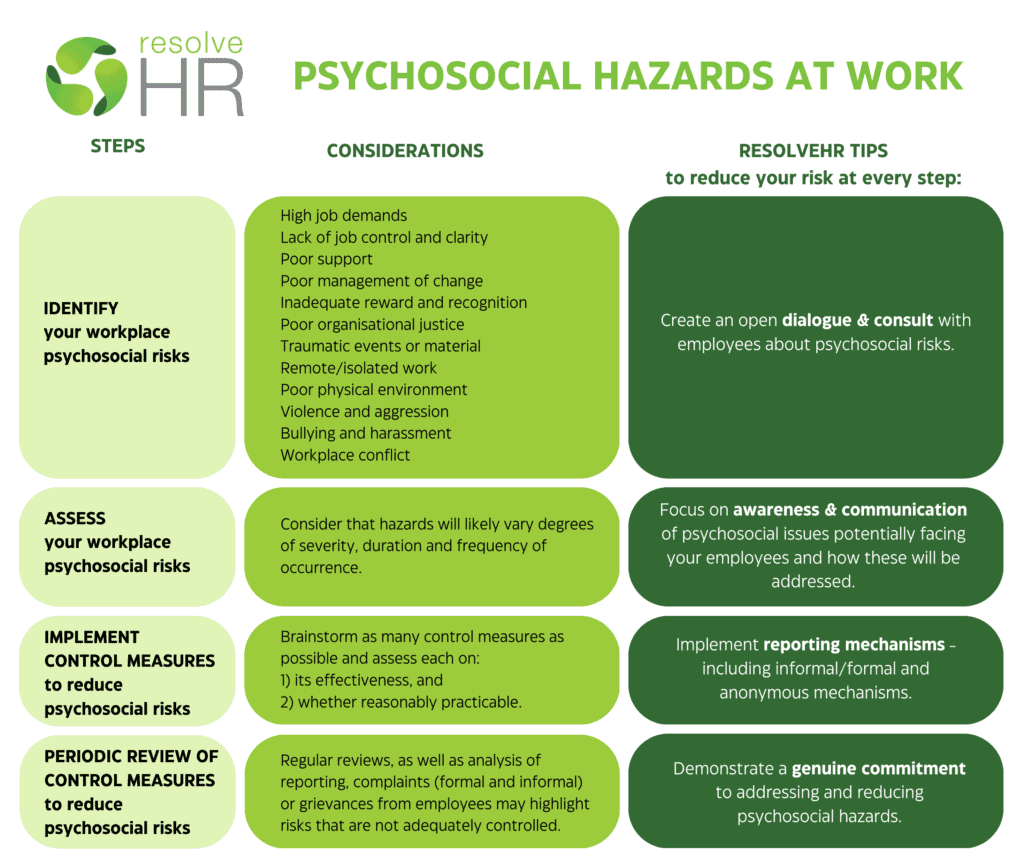More than ever, employers are required to undertake a wholistic and proactive approach to ensuring workplace health and safety.
Psychosocial hazards, risks and issues (defined as: anything that could cause psychological harm, for example: harm to someone’s mental health)[1]are now at the fore, driven largely by a recent independent review of Australia’s model WHS laws and the impact of the COVID-19 pandemic on mental health.
In many ways, this is nothing new: under the Work Health and Safety Act 2011 (WHS Act) the primary duty of care for Person’s Conducting a Business or Undertaking (PCBUs) is to ensure ‘so far as is reasonably practicable, the health (including psychological health) and safety of each worker’[2].
What has changed, is the broader shift in state based workplace safety legislation to lift the minimum standards expected of employers in managing psychological risks in their workplaces.
- In NSW, from 1 October 2022, under the Work Health and Safety Amendment Regulation (NSW Regulation) PCBU’s are explicitly required to manage psychosocial risks in the same way that other risks to health and safety (i.e. physical risks) are dealt with under the NSW Regulation.
- Safework NSW has published a Code of Practice for Managing Psychosocial Hazards at work.
- In QLD, from 1 April 2023, the Managing the risk of psychosocial hazards at work Code of Practice 2022 is an approved code of practice under the WHS Act.
- WA and NT have also adopted the SafeWork Code of Practice model as a Code of Practice in their jurisdictions.
- Other states are expected to follow with relevant legislative updates and Codes of Practice to address psychosocial hazards.
Put simply, the traditional approach to Workplace Health and Safety is no longer enough. It will no longer be enough to focus on physical safety; to have a reactive approach to dealing with psychosocial issues; and to only manage these risks at an administrative level, or through policy.
To identify, understand, address and minimise psychosocial risks, we’re working with clients in line with the relevant Code of Practice to assist PCBUs in ensuring they meet their obligations and reduce risk. Using the principals outlined in the Safe Work Australia Model Code of Practice for Managing Psychosocial Hazards at Work [3] the flow chart below outlines the Key Steps, Considerations and ResolveHR Tips for reducing the risk of psychosocial hazards:
[1] https://www.safeworkaustralia.gov.au/safety-topic/managing-health-and-safety/mental-health/psychosocial-hazards
[2] https://www.safework.nsw.gov.au/resource-library/list-of-all-codes-of-practice/codes-of-practice/managing-psychosocial-hazards-at-work?result_397396_result_page=2
[3] https://www.safeworkaustralia.gov.au/sites/default/files/2022-07/model_code_of_practice_-_managing_psychosocial_hazards_at_work.pdf
the Key Steps, Considerations and ResolveHR Tips for reducing the risk of psychosocial hazards:

We are currently consulting with our clients to determine a pragmatic, practical and tailored approach to addressing and minimizing psychosocial risks in their workplaces. Get in touch if we can assist.
Nick Hedges is the founder of Resolve HR, a Sydney-based HR consultancy specialising in providing workplace advice to managers and business owners. He recently published his first book, “Exiting underperforming Team Members – The Inside Scoop”. It is a practical response to the most pressing HR challenges, which can be found at https://resolvehr.com.au/.
Disclaimer: The contents written do not constitute legal advice and does not cater for individual circumstances. The information contained herein is not intended to be a substitute for legal advice and should not be relied upon as such.
